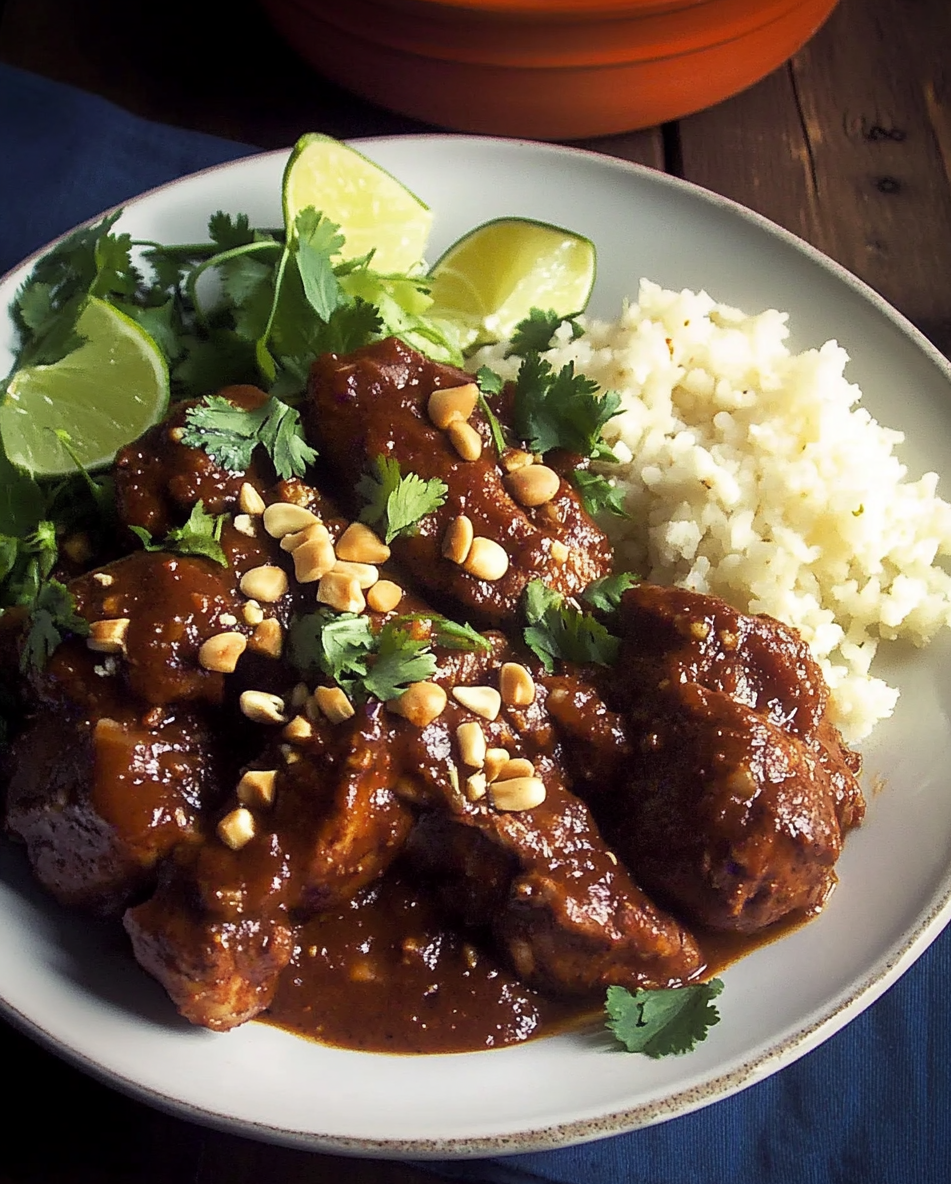Chicken Mole is a classic Mexican dish that masterfully blends savory and sweet elements. The rich, velvety mole sauce – infused with chocolate, spices, and a hint of peanut butter – brings out the tender flavor of chicken, creating a symphony of deep, bold flavors. This dish is a true showcase of Mexican cuisine’s complexity and charm.
Perfect for a hearty family dinner or an impressive meal for guests, this Chicken Mole pairs beautifully with rice or tortillas. The garnish of toasted sesame seeds adds a delightful crunch that complements the smooth sauce. Whether you’re a seasoned mole enthusiast or trying it for the first time, this dish will leave a lasting impression with its unique, rich taste.
Full Recipe:
- 1 tablespoon vegetable oil
- 4 skinless, boneless chicken breast halves
- 1 (19-ounce) can mole sauce (such as Dona Maria®)
- 1 cup chicken broth
- 1 tablespoon peanut butter
- 1 tablespoon semisweet chocolate chips
- 1 teaspoon ground cinnamon
- 1/4 teaspoon ground cloves
- 1/4 teaspoon ground allspice
- 1/4 cup sesame seeds (for garnish)
Directions:
- Heat oil in a large skillet over medium heat. Add chicken breasts and cook for about 5 minutes on each side, or until browned.
- In a bowl, combine mole sauce, chicken broth, peanut butter, chocolate chips, cinnamon, cloves, and allspice. Stir until smooth.
- Pour the sauce mixture over the browned chicken breasts. Reduce heat to low and simmer for 25-30 minutes, or until chicken is cooked through and tender.
- Transfer the chicken to a serving platter and spoon the mole sauce over the top. Garnish with sesame seeds before serving.
Prep Time: 10 minutes | Cooking Time: 30 minutes | Total Time: 40 minutes
Kcal: 360 kcal | Servings: 4 servings
Origins and History
Mole has its roots in pre-Hispanic Mexico, where indigenous peoples used native ingredients like chili peppers, tomatoes, and cacao to create sauces for their meals. The addition of Old World ingredients, such as nuts and spices brought by Spanish colonizers, helped to shape the mole we know today. Mole is traditionally associated with the regions of Puebla and Oaxaca, but there are many variations across Mexico. It is often served at celebrations, special occasions, and religious holidays.
Key Elements of Mole Sauce
- Chili Peppers: Mole often includes a combination of dried chili peppers such as ancho, pasilla, and mulato, which provide a smoky, spicy base for the sauce.
- Chocolate: Cacao has been used in Mexican cuisine for centuries. The chocolate in mole is typically unsweetened or bittersweet, providing a subtle depth of flavor rather than overwhelming sweetness.
- Spices: Cinnamon, cloves, and allspice are common spices in mole, adding warmth and complexity.
- Nuts: Ingredients like peanuts, almonds, or seeds (such as sesame) are often included, giving mole a creamy texture.
- Sweet and Savory Balance: Mole is a dance between spicy, savory, and sweet elements, with sugar or honey sometimes added to balance out the flavors.
Modern Variations
While mole poblano remains a beloved classic, modern variations of mole have emerged. Some moles are sweeter, while others are more savory, with regional differences highlighting local ingredients. For example, mole negro from Oaxaca is known for its deep black color and intense smoky flavor, while mole verde uses fresh herbs like cilantro and parsley for a brighter, more herbal sauce.
Tips for Serving Chicken Mole
- Rice: Serve chicken mole with fluffy white rice to absorb the sauce.
- Tortillas: Warm corn tortillas make the perfect accompaniment for scooping up the rich sauce.
- Beans: A side of refried beans or black beans complements the robust flavors of mole.
- Toppings: Toasted sesame seeds or a sprinkle of fresh herbs, such as cilantro, add a finishing touch to the dish.
Nutritional Information
Chicken mole is relatively high in calories due to its rich sauce, but it is also packed with nutrients from its variety of ingredients. The chicken provides a lean source of protein, while the mole sauce is filled with antioxidants from chili peppers, cacao, and spices. When made with healthy fats like olive oil, the dish offers a balanced meal with a unique nutritional profile.
The Cultural Significance of Mole
Mole is more than just a dish; it’s a symbol of Mexican identity and cultural pride. In many Mexican households, mole is prepared for special occasions like weddings, baptisms, and national holidays such as Mexico’s Independence Day or Día de los Muertos (Day of the Dead). The labor-intensive process of making mole from scratch is often seen as an act of love and devotion, passed down through generations.
In fact, mole is so integral to Mexican culinary culture that it has been declared part of the country’s intangible cultural heritage by UNESCO. It brings families and communities together, with traditional recipes often being a well-guarded secret in some families, only shared with the next generation.
The Art of Balancing Flavors in Mole
One of the most fascinating aspects of mole is the incredible balance of flavors it achieves. Mole exemplifies the concept of umami, a savory taste sensation that adds depth and richness. The combination of chilies, spices, and chocolate creates layers of complex flavors that are both robust and harmonious.
- Chilies: The variety of dried chilies used in mole not only provides heat but also a smoky, earthy flavor. Ancho chilies, for example, are mild and fruity, while mulato chilies have a chocolatey undertone. The mix of chilies adds complexity without overwhelming the dish with spiciness.
- Chocolate: While the inclusion of chocolate may sound unusual to some, its role in mole is not to make the dish sweet but to deepen the flavor. It adds a smooth, velvety texture to the sauce and enhances the savoriness of the other ingredients.
- Acidic and Sweet Elements: Mole recipes often incorporate a hint of sweetness, whether through dried fruits like raisins, sugar, or even plantains. The sweetness balances out the acidity from tomatoes or tomatillos and the bitterness of chocolate and spices.
The Labor of Love Behind Mole
Traditional mole is known for being a time-consuming recipe that involves toasting, grinding, and simmering a large number of ingredients. In many cases, over 20 different ingredients are used to make a mole sauce. These ingredients are carefully toasted or roasted to release their essential oils and deepen their flavors, and then ground into a paste.
In older times, families used large stone mortars called molcajetes to manually grind the ingredients into a smooth paste. Today, the process is often streamlined with the use of blenders and pre-made mole pastes like the one used in this recipe, but the essence of the dish remains the same.
Regional Variations of Mole
While mole poblano (as featured in your Chicken Mole recipe) is the most famous version, there are many types of mole that highlight different ingredients and regions across Mexico.
- Mole Negro: Hailing from Oaxaca, this is perhaps the richest and darkest version of mole, made with roasted chilies, chocolate, and sometimes blackened plantains. It has a deep, smoky flavor and is often reserved for very special occasions.
- Mole Verde: Known for its fresh, bright green color, mole verde is made with ingredients like tomatillos, cilantro, and green chilies. It has a tangy, herbal flavor and is lighter compared to other moles.
- Mole Amarillo: Another Oaxacan variant, mole amarillo (yellow mole) gets its bright color from yellow chilies and turmeric. This version is less sweet and more focused on the savory aspects of the sauce.
- Mole Coloradito: This version is a beautiful reddish hue, made with tomatoes and achiote seeds. It has a slightly sweet, earthy flavor and is often served with pork or beef.
Each region of Mexico has its own spin on mole, utilizing local ingredients to create unique variations of this beloved dish.
Tips for Perfecting Chicken Mole
- Choose Quality Ingredients: Since mole has such a rich depth of flavor, it’s essential to use high-quality ingredients. Opt for unsweetened or bittersweet chocolate that is at least 70% cacao, and fresh spices for the most authentic taste.
- Simmer Slowly: Mole is a dish that benefits from patience. Letting the sauce simmer slowly allows the flavors to meld together beautifully. Mole sauce tastes even better the next day, so consider making it ahead of time if you’re preparing for a special event.
- Adjust the Spice: Mole can be as mild or as spicy as you prefer. If you’re making this for a crowd, you can easily adjust the heat level by selecting milder chilies or reducing the amount of spicy chilies like chipotles.
- Serve with Traditional Sides: Mole is traditionally served with Mexican red rice (arroz rojo) or plain white rice. You can also add warm corn tortillas, refried beans, or a fresh green salad on the side for a complete meal.
Fun Facts About Mole
- World Record: In 2012, the town of Puebla set a world record by preparing the largest batch of mole ever made. The dish weighed over 3,300 kilograms and was prepared by more than 2,000 people!
- Historical Significance: Mole has deep ties to Mexican history. Legend has it that the dish was created by nuns in a convent in Puebla in the 17th century. When they heard that the archbishop was coming for a visit, they scrambled to prepare a special dish. Using the ingredients they had on hand, they combined spices, chocolate, and chilies to create mole.
- Festivals: Mexico celebrates mole with festivals and fairs. Puebla holds an annual mole festival called Feria de Mole Poblano where visitors can sample different variations and even take part in mole-making competitions.
Conclusion
Chicken Mole is a dish that beautifully represents the rich culinary heritage of Mexico, blending bold flavors with a touch of sweetness from chocolate and spices. Whether you’re making it for a special occasion or a cozy family dinner, this flavorful dish is sure to impress. Its deep, complex sauce, combined with tender chicken, creates a truly unforgettable meal. Mole is more than just a recipe—it’s a celebration of Mexico’s vibrant culture and history, bringing generations together through shared tradition and love of good food. Give this authentic Chicken Mole recipe a try, and enjoy a taste of Mexico at home!






